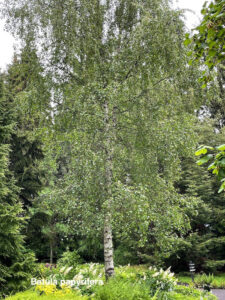Suzanne Simard and Birches
 Last week’s story about competition vs. cooperation in evolution elicited this reaction from a reader: “Your description of Simard’s work, which emphasizes how mother trees recognize seedlings in their own species, then pass carbon, nutrients and water to their kin to help them survive, is actually a dramatic confirmation of ‘Darwinian thinking’, rather than flying in its face. Darwin never wrote of ‘an everlasting struggle to dominate’. That is a popular vulgarization of his ideas. He emphasized that those species best able to pass their traits on to future generations were the best fit. Darwin did not know about genes — that came a half-century later. So, the modern interpretation of his ideas says that the more successful an organism is in passing on its genes, the more ‘fit’ it is in the grand evolutionary scheme of things. Trees have ‘discovered’ that by passing essential elements to their kin, they have insured that their genetic makeup survives into the next generation.”
Last week’s story about competition vs. cooperation in evolution elicited this reaction from a reader: “Your description of Simard’s work, which emphasizes how mother trees recognize seedlings in their own species, then pass carbon, nutrients and water to their kin to help them survive, is actually a dramatic confirmation of ‘Darwinian thinking’, rather than flying in its face. Darwin never wrote of ‘an everlasting struggle to dominate’. That is a popular vulgarization of his ideas. He emphasized that those species best able to pass their traits on to future generations were the best fit. Darwin did not know about genes — that came a half-century later. So, the modern interpretation of his ideas says that the more successful an organism is in passing on its genes, the more ‘fit’ it is in the grand evolutionary scheme of things. Trees have ‘discovered’ that by passing essential elements to their kin, they have insured that their genetic makeup survives into the next generation.”
Simard’s recent work has focused on Douglas-fir trees, but she has also extensively studied birch trees, particularly two species that we have in the Garden. Her initial discoveries, detailed in her new book, of how plants communicate through fungal networks involved the paper bark birch (Betula papyrifera), which forms an integral part of our temperate rainforests. She found that removing these trees when re-planting a logged area has a very negative effect on the survival of newly planted seedlings because they lose the nutritive underground support of the birch. Our Garden’s paper birches are found in the BC Habitat area and in the Western North America Garden.
Later work involved dwarf birch (Betula nana), which grows in arctic and cool temperature regions and is grazed by animals. Simard and her colleagues’ research on Betula nana showed that below-ground carbon transfer through fungal networks increased as the outside temperature warmed up. This causes the birch to outgrow other species and is a factor in the greening of the Arctic. VanDusen Garden is in the southern part of the dwarf birch distribution, and we have a small specimen planted in 1974 in the Stanley Smith Alpine Garden.
